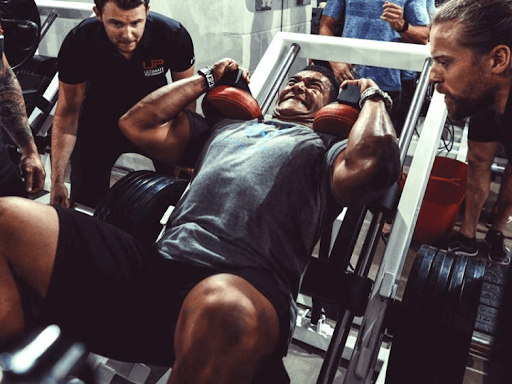
4 Reasons why your Muscles are not Growing

In most cases, it won’t be the big things that are limiting your muscle growth and holding you back; it will be the small things.
You probably know many people who claim to work out every single day, for hours at a time, but there is very little about the appearance of these particular people that would lead you to believe that they work out frequently, if at all. By the same token, there are other people who exercise only a few days each week, for short stretches, and their bodies look far more impressive than those of the people that claim to exercise for far longer.
This doesn’t mean the people who exercise for long periods of time are lying. It means there are different things happening before, during and after their workouts that are contributing to the effectiveness of those workouts, and also to the results of those workouts on those people’s bodies.
If you’re not achieving the results you desire from your workouts, there’s no need to panic. You probably just need to tweak small things in one to four areas of your training in order to see major changes in the quality of your physique, along with other measurable results.
To help you out, and to help you get the most out of every single strength-training session you participate in, here are four reasons why your muscles are not growing the way you would like them to.

Your Workouts Lack Intensity
Your muscles respond to intensity. Hypertrophy, or the growth of muscle, comes as a direct result of the intensity you perform your exercises with. There are plenty of people who arrive at the gym and go through the motions of performing exercises, and they may even perform all of the correct exercises with proper form, and support their workouts on the back end with proper nutrition. However, their inability to make any recognizable gains is caused by the simple fact that they don’t perform their exercises with any intensity. As a result, all of the proper forethought they give toward performing the right exercises in the proper distribution of sets and reps is all for naught.
A muscle only grows after it has been worn down through intense training. From there, the muscles rebuild themselves in a stronger configuration, which allows them to lift even more weight the next time they are trained. This is the only way that sustained, meaningful muscle growth occurs, and none of this happens if you don’t lift with the intensity required to break your muscles down so that they can be rebuilt to be large and powerful.
You don’t measure progress by how sore you are, or by how much time you physically spent at the gym working out. Instead, you measure progress in ways that are measurable and visible. The ability to perform more controlled reps with the same weight, or the ability to lift heavier weight with good form, is an example of progress. Another example of progress is an obvious improvement in the way your body looks. Remember that you need to maximize every single rep during every single workout, and intensity is a huge factor in stimulating muscle growth.

You’re Not Taking Adequate Time to Recover
The big problem with recovery is there are so many people who are so eager to grow that they don’t think about recovery time or recognize its importance. On top of that, there are many people that don’t fully understand when their muscles are actively in the process of growing.
Your muscles don’t grow at all from the initial pump of training; they grow larger and stronger while you’re resting. After the muscle recovers, you’ll be able to lift heavier weights, and you’ll be able to increase the number of reps you can do.
Instead of choosing to rest, a lot of people overtrain their muscles. When overtaining occurs, these people’s bodies never get the opportunity to repair the muscle tissues that were torn while they were working out. When that happens, the muscles begin to atrophy, and they become stagnant in their growth.
Give you muscles between two to three day to recover after you’ve worked them strenuously. While they’re recovering, make sure you fuel them properly, and make sure you’re getting plenty of rest and sleep. If you can do that without overtraining your muscles, you’ll be providing yourself with a vastly improved chance of maximizing your growth potential.

You’re Lifting With Improper Form
One of the most common sights in gyms across the world involves people who are willing to sacrifice life and limb to lift a weight, no matter how heavy it is, or no matter how awful their lifting form is. These people are usually lifting with their egos because they want to impress people around them with the size and quantity of the weights they’re lifting, or because they want to be able to brag to their friends about how much weight they were strong enough to move.
The reality is that hardly any of the weightlifting they performed with incorrect form will translate into meaningful muscle growth. They sacrificed the opportunity to have a productive workout for the sake of impressing a few people around them. It’s also possible that they’ve injured themselves in the process of training with far more weight than they ever should have dared to lift.
People sacrifice form in a few ways. One way involves using momentum to float the weights through the section when the muscles are supposed to be working their hardest, which is very common during several shoulder exercises. Another way to sacrifice proper form involves shortening the distance that the weight travels, or by failing to retain the ideal body posture throughout a lift.
All of these failures to maintain proper form are common ways that people injure themselves while training. Remember, when you sacrifice proper form to complete a rep, that rep doesn’t count the way you’d like it to, and the results won’t materialize the way you’d like them to either.
You should never sacrifice the form of your lifts for the sake of being able to move heavier weights. Instead, make sure you concentrate on maintaining impeccable form, because maintaining good form is going to keep you from getting injured, and it’s going to get you the results you’re looking for.

You’re Not Breaking Your Training Into The Proper Sets
A lot of times you hear people say to do three or four sets of an exercise, and you may be wondering why this is necessary.
The reason why you’d want to do three or four sets is simple to explain. The first set is supposed to break down 50-to-60 percent of the muscle group being trained so that it can repair itself and recover according to the stress being applied to it. Then, the second set is supposed to break the muscle group down from 50-to-70 percent, and the third set is supposed to break down the muscle group down by up to 80 percent.
You don’t want to break the muscle group down any more than 80 percent because that muscle becomes substantially more vulnerable to a real injury. Remember, you’re micro tearing the muscle as you’re training it, so you’re creating small tears that are having small repairs made to them during your recovery stage. You don’t want to get a serious tear from overworking the muscle.
In light of this, you should select the number of sets you’re going to train based on how thoroughly you intend to tear the muscle group down. Also, if you’re concentrating on building the muscle, you want to make sure you’re using every muscle fiber, and not simply concentrating on manipulating the weight and getting the weight up. Make sure you have every muscle fiber firing so you can achieve full development. If you’re doing fewer than eight repetitions, you’re really only concentrating on completing the repetitions rather than maximizing the number of muscle fibers that are firing. Stay within the eight-to-12 rep range to achieve the best results.
I hope this explanation of why your muscles may not be growing will help you to improve your workouts and kickstart a fresh round of muscle growth for you.
For more great fitness tips, feel free to check out the rest of the blog at RonWilliamsFitness.com, and also the Ron Williams channel on YouTube!

